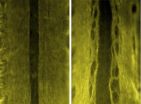(Press-News.org) Obese, postmenopausal women are at greater risk for developing breast cancer and their cancers tend to be more aggressive than those in lean counterparts. A University of Colorado Cancer Center study published in the December issue of the journal Cancer Research shows how this risk might be prevented.
"By using nutrient tracers for fat and sugar, we tracked where the body stored excess calories. In lean models, excess fat and glucose were taken up by the liver, mammary and skeletal tissues. In obese models, excess fat and glucose were taken up by tumors, fueling their growth," says Erin Giles, PhD, postdoctoral researcher at the CU Cancer Center and the paper's lead author.
In short, if you are lean, excess calories go to healthy tissue. If you are obese, excess calories feed the tumor.
"This implies that the menopausal window may be an opportunity for women to control their breast cancer risk through weight management," Giles says.
In this study, Giles worked with a team of scientists including postdoctoral fellows Elizabeth Wellberg and Sonali Jindal, as well as faculty members Steve Anderson, Pepper Schedin, Ann Thor and Paul Maclean. Their study also showed that tumors from obese animals had increased levels of the progesterone receptor, and this receptor appears to give tumors a metabolic advantage for growth. To extend their findings to humans, they recruited gene analysis experts David Astling and Aik-Choon Tan who analyzed 585 human breast cancers and found that human tumors expressing the progesterone receptor had the same metabolic advantage.
"Basically, we saw an abnormal metabolic response to fat and sugar in the obese that, in many ways, mirrors the response to fat and sugar in Type II diabetes," Giles says. Noticing this similarity, the group tested the use of the common Type II diabetes drug, Metformin, in their model of postmenopausal breast cancer.
"With treatment, tumor size was dramatically decreased in the obese, and tumors showed reduced expression of the progesterone receptor," Giles says.
Using a pre-clinical model, the investigators found that weight gain during menopause is particularly bad for those who are obese when entering menopause. Together, the results of this study suggest that the combination of obesity and weight gain during menopause can impact breast cancer in two ways. First, tumors that arise in obese women appear to have a metabolic advantage, and second, the inability to store excess calories in healthy tissues may further fuel tumor growth.
"While drugs may be useful in controlling breast cancer risk in obese, postmenopausal women, our results imply that a combination of diet and exercise may be equally if not more beneficial," Giles says.
The group's ongoing studies are testing whether interventions such as diet and exercise, during the period of menopausal weight gain, can improve tumor outcomes.
### END
Healthy lifestyle during menopause may decrease breast cancer risk later on
Combination of diet and exercise may be as beneficial as drugs
2012-12-19
ELSE PRESS RELEASES FROM THIS DATE:
Protein creates paths for growing nerve cells
2012-12-19
Working with mice, Johns Hopkins scientists have discovered that a particular protein helps nerve cells extend themselves along the spinal cord during mammalian development. Their results shed light on the subset of muscular dystrophies that result from mutations in the gene that holds the code for the protein, called dystroglycan, and also show how the nerve and muscle failings of the degenerative diseases are related.
As mammals like mice and humans develop, nerve cells in the brain and spinal cord must form connections with themselves and with muscles to assure proper ...
Small, portable sensors allow users to monitor exposure to pollution on their smart phones
2012-12-19
Computer scientists at the University of California, San Diego have built a small fleet of portable pollution sensors that allow users to monitor air quality in real time on their smart phones. The sensors could be particularly useful to people suffering from chronic conditions, such as asthma, who need to avoid exposure to pollutants.
CitiSense is the only air-quality monitoring system capable of delivering real-time data to users' cell phones and home computers—at any time. Data from the sensors can also be used to estimate air quality throughout the area where the ...
Host cholesterol secretion likely to influence gut microbiota
2012-12-19
For more than half a century, researchers have known that the bacteria that colonize the gastrointestinal tract of mammals influence their host's cholesterol metabolism. Now, Jens Walter and colleagues of the University of Nebraska show that changes in cholesterol metabolism induced by diet can alter the gut flora. The research was published online ahead of print in the journal Applied and Environmental Microbiology.
In the study, the researchers added plant sterol esters to the diets of hamsters. The overall effect of this was to inhibit several bacterial taxa, from ...
Tracking the origins of HIV
2012-12-19
URBANA – Human immunodeficiency virus (HIV) may have affected humans for much longer than is currently believed. Alfred Roca, an assistant professor in the College of Agricultural, Consumer and Environmental Sciences at the University of Illinois, thinks that the genomes of an isolated West African human population provide important clues about how the disease has evolved.
HIV is thought to have originated from chimpanzees in central Africa that were infected with simian immunodeficiency virus (SIV), a retrovirus. "If you look at the diversity present across SIV in chimpanzees, ...
Are we closing in on dark matter?
2012-12-19
This fall, the Kavli Institute for Cosmological Physics at the University of Chicago and the National Academy of Sciences organized a colloquium that brought together more than 100 cosmologists, particle physicists and observational astrophysicists – three fields now united in the hunt to determine what is dark matter. Their goal: to take stock of the latest theories and findings about dark matter, assess just how close we are to detecting it and spark cross-disciplinary discussions and collaborations aimed at resolving the dark matter puzzle.
So where do things stand? ...
MRIs reveal signs of brain injuries not seen in CT scans, UCSF/SFGH researchers report
2012-12-19
Hospital MRIs may be better at predicting long-term outcomes for people with mild traumatic brain injuries than CT scans, the standard technique for evaluating such injuries in the emergency room, according to a clinical trial led by researchers at the University of California, San Francisco (UCSF) and the San Francisco General Hospital and Trauma Center (SFGH).
Published this month in the journal Annals of Neurology, the study was led by UCSF neuroradiologist Esther Yuh, MD, PhD and followed 135 people treated for mild traumatic brain injuries over the past two years ...
Penn metamaterials experts show a way to reduce electrons' effective mass to nearly 0
2012-12-19
PHILADELPHIA — The field of metamaterials involves augmenting materials with specially designed patterns, enabling those materials to manipulate electromagnetic waves and fields in previously impossible ways. Now, researchers from the University of Pennsylvania have come up with a theory for moving this phenomenon onto the quantum scale, laying out blueprints for materials where electrons have nearly zero effective mass.
Such materials could make for faster circuits with novel properties.
The work was conducted by Nader Engheta, the H. Nedwill Ramsey Professor of Electrical ...
Ozone levels have sizeable impact on worker productivity
2012-12-19
December 18, 2012 -- Researchers in the Department of Health Policy and Management at Columbia's Mailman School of Public Health assessed the impact of pollution on agricultural worker productivity using daily variations in ozone levels. Their results show that ozone, even at levels below current air-quality standards in most parts of the world, has significant negative impacts on worker productivity. Their findings suggest that environmental protection is important for promoting economic growth and investing in human capital in contrast to its common portrayal as a tax ...
Analysis of Marcellus flowback finds high levels of ancient brines
2012-12-19
UNIVERSITY PARK, Pa. -- Brine water that flows back from gas wells in the Marcellus Shale region after hydraulic fracturing is many times more salty than seawater, with high contents of various elements, including radium and barium. The chemistry is consistent with brines formed during the Paleozoic era, a study by an undergraduate student and two professors in Penn State's Department of Geosciences found.
The study indicates that the brine flowback elements found in high levels in the late stages of hydraulic fracturing come from the ancient brines rather than from salts ...
Robotic-assisted radical bladder surgery potentially benefits bladder cancer patients
2012-12-19
New York, NY, December 19, 2012 – About 30 percent of the more than 70,000 bladder cancer cases expected in 2012 are muscle invasive. In such cases, radical cystectomy is the preferred treatment. In a pilot trial, a team of investigators assessed the efficacy of open radical cystectomy (ORC) vs. robotic-assisted laparoscopic radical cystectomy (RARC). While there were no significant differences in treatment outcomes, RARC resulted in decreased estimated blood loss and shorter hospital stay compared to ORC. The results are published in the February 2013 issue of The Journal ...
LAST 30 PRESS RELEASES:
University of Oklahoma researcher awarded funding to pursue AI-powered material design
Exploring how the visual system recovers following injury
Support for parents with infants at pediatric check-ups leads to better reading and math skills in elementary school
Kids’ behavioral health is a growing share of family health costs
Day & night: Cancer disrupts the brain’s natural rhythm
COVID-19 vaccination significantly reduces risk to pregnant women and baby
The role of vaccination in maternal and perinatal outcomes associated with COVID-19 in pregnancy
Mayo Clinic smartwatch system helps parents shorten and defuse children's severe tantrums early
Behavioral health spending spikes to 40% of all children’s health expenditures, nearly doubling in a decade
Digital cognitive behavioral treatment for generalized anxiety disorder
Expenditures for pediatric behavioral health care over time and estimated family financial burden
Air conditioning in nursing homes and mortality during extreme heat
The Alps to lose a record number of glaciers in the next decade
What makes a good proton conductor?
New science reporting guide published for journalists in Bulgaria
New international study reveals major survival gaps among children with cancer
New science reporting guide published for journalists in Turkey
Scientists develop a smarter mRNA therapy that knows which cells to target
Neuroanatomy-informed brain–machine hybrid intelligence for robust acoustic target detection
Eight SwRI hydrogen projects funded by ENERGYWERX
The Lundquist Institute and its start-up company Vitalex Biosciences Announces Strategic Advancement of Second-Generation fungal Vaccine VXV-01 through Phase 1 Trials under $40 Million Competitive Con
Fine particles in pollution are associated with early signs of autoimmune disease
Review article | Towards a Global Ground-Based Earth Observatory (GGBEO): Leveraging existing systems and networks
Penn and UMich create world’s smallest programmable, autonomous robots
Cleveland researchers launch first major study to address ‘hidden performance killer’ in athletes
To connect across politics, try saying what you oppose
Modulating key interaction prevents virus from entering cells
Project explores barriers to NHS career progression facing international medical graduates
Jeonbuk National University researchers explore the impact of different seasonings on the flavor perception of Doenjang soup
Two Keck Medicine of USC Hospitals named Leapfrog Top Teaching Hospitals
[Press-News.org] Healthy lifestyle during menopause may decrease breast cancer risk later onCombination of diet and exercise may be as beneficial as drugs

